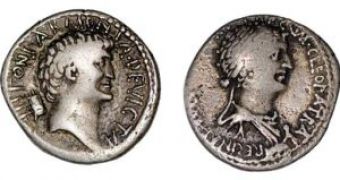Her legend has grown over the centuries and literature and art depicted her as a queen of beauty. Chaucer, in the 14th century, regarded her as "fair as is the rose in May."
And Shakespeare, too, had a heavy word "Age cannot wither her, nor custom stale her infinite variety; other women cloy the appetites they feed, but she makes hungry where most she satisfies."
Many movies just reinforced this image.
Cleopatra, the queen of Egypt, lived 69 BC - 30 BC and co-ruled with her father Ptolemy XII (descendant of one of the Alexander's generals), her brothers/husbands Ptolemy XIII and Ptolemy XIV and had a liaison with Julius Caesar (with whom she had a son, Caesarion) that strengthened her grip on the power.
After Caesar's assassination, aligned with Mark Antony, with whom she had twin boys and a girl.
Her unions with her brothers produced no children: it is possible that they were never consummated; in any case, they were not close. Her reign marks the final end.
After Antony's rival and Caesar's legal heir, Octavian Augusts, the later first Roman Emperor, defeated her and Mark Antony, Cleopatra committed suicide by means of a venomous snake.
That meant the end of the Hellenistic (Greek culture) and the beginning of the Roman era in Egypt and Middle East.
We may think that this woman must have been an extraordinary beauty to have turned crazy the most powerful men of her time and to inflame the imagination of so many artists, writers and artists.
But researchers at Britain's University of Newcastle add another proof to the already existing ones confirming that in reality the queen must have been rather ugly: images from a Roman denarius coin show the famous Egyptian as a sharp-nosed, thin-lipped woman with a protruding chin, a fit match for the hook-nosed, thick-necked Mark Antony on the other side of the coin.
"The image on the coin is far from being that of Elizabeth Taylor and Richard Burton," said Lindsay Allason-Jones, director of archaeological museums at the university, alluding the 1963 film "Cleopatra", depicting the romance between the two.
Even the ancient historian Plutarch, in the "Life of Antony" written a century after the great romance, told of Cleopatra: "her actual beauty, it is said, was not in itself so remarkable that none could be compared with her."
"But the contact of her presence, if you lived with her, was irresistible; the attraction of her person, joining with the charm of her conversation, and the character that attended all she said or did, was something bewitching. It was a pleasure merely to hear the sound of her voice ..."
Photo credit: Newcastle University.

 14 DAY TRIAL //
14 DAY TRIAL //